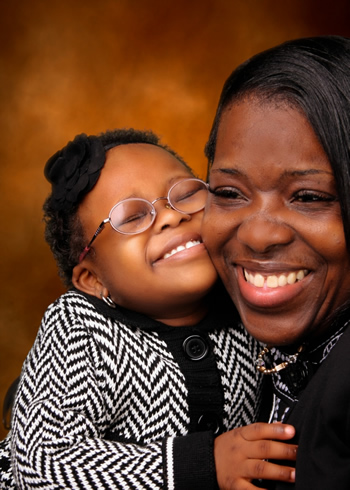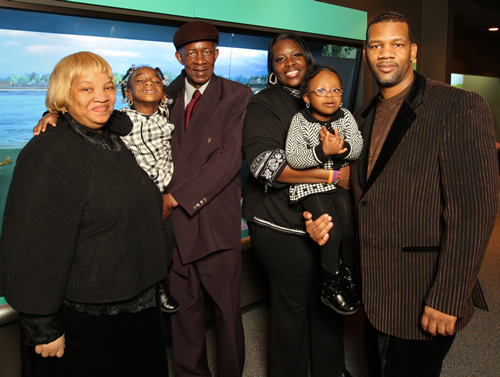Miracle Kids: Arieona Beasley
Beautiful, Bubbly Toddler with Down Syndrome Faces Cancer Head-On
 It seemed like a simple cold at first, when Sandra Beasley took her 2-year-old daughter, Arieona, to the pediatrician and returned home with instructions to administer some ibuprofen. But the next week, when Sandra drove up to her mother-in-law’s house to pick up her two children, Arieona, who goes by Arie, didn’t run outside with her usual enthusiastic greeting.
It seemed like a simple cold at first, when Sandra Beasley took her 2-year-old daughter, Arieona, to the pediatrician and returned home with instructions to administer some ibuprofen. But the next week, when Sandra drove up to her mother-in-law’s house to pick up her two children, Arieona, who goes by Arie, didn’t run outside with her usual enthusiastic greeting.
She was sitting by the door with her hands on her hips. Her breathing was labored, and her skin was a pale color her mother had never seen before.
“I looked at her hands, then I looked at my hands, then I looked at her hands,” recalled Sandra. “I was scared it was serious.”
Within 10 minutes, they were back at the pediatrician’s office, where they drew blood and immediately sent Arie to Golisano Children’s Hospital at the University of Rochester Medical Center. By the time they arrived, Arie was even more lethargic, and she was soon admitted to the Pediatric Intensive Care Unit.
“When they left us alone, I was like, ‘What did I do to deserve this?’” Sandra said. “Every name I could think of for God, I called him. Jehovah-Jireh, Jesus Lord, Master King. And I was even praying to my mom, who passed away more than 20 years ago. I said, ‘You sit up there and talk to him. Just don’t let him take my baby.’”
Though initial blood tests showed she had low white blood cell, hemoglobin and platelet counts, which suggested a potential bacterial infection, a follow-up bone marrow aspiration confirmed suspicion of acute myeloid leukemia, otherwise known as AML. The disease, which affects approximately 500 children in the U.S. each year, is characterized by white blood cells that accumulate in the bone marrow, interfere with the production of normal blood cells, and can spread to other parts of the body.
Arie’s course of treatment was intense and spread out over seven months. She was hospitalized each month for a seven-day stretch to undergo daily chemotherapy sessions, and had monthly bone marrow aspirations to assess her response to treatment, as well as spinal taps to make sure the leukemia did not spread.
“It was a lot to go through,” said Jeffrey R. Andolina, M.D., M.S., an assistant professor of Pediatric Hematology/Oncology at Golisano Children’s Hospital. “But she’s such an energetic and happy child, and very resilient, so she tolerated things really well.”
To overlap with her regular care, Arie’s family decided to enroll her in a clinical trial through Children’s Oncology Group, a cooperative research network that offers the latest and best protocols for treating pediatric cancers. The new chemotherapy regimen she was given had been developed specifically to decrease side effects in children under age 4, with both Down Syndrome and AML. Arie met all of the criteria.
Children with Down Syndrome are about 15 times more likely to develop AML, but while they also have a better long-term AML survival rate than those who do not have Down Syndrome—about 80 percent compared to roughly 50 percent—they tend to be more sensitive to chemotherapy’s side effects. Besides nausea, Arie experienced several serious fever episodes that kept her hospitalized an additional two to three weeks at a time.
“She didn’t let any of it bother her,” Sandra said. “Every day, she handled it.”
More than that, on her best days, she was often seen running down the hospital halls, hugging the nurses, and rubbing Dr. Andolina’s head. Her exuberant personality earned her a nickname: “Mayor of the Fourth Floor.” In her more subdued moments, she repeatedly watched Shrek movies and perfected the art of sleeping in until noon.
Just as she was finishing up her treatments, Arie, who had a weakened immune system, contracted a very severe abdominal infection that caused high fevers, abdominal cramping and diarrhea, and required an extra week of hospitalization.
All in all, Arie was hospitalized five of the seven months she received care at Golisano Children’s Hospital—a highly unusual length of time and one that caused some anxiety once she returned home to a place that wasn’t nearly as familiar as her hospital room.
 “Do you know where you are?” Sandra asked one early evening after the toddler awoke.
“Do you know where you are?” Sandra asked one early evening after the toddler awoke.
Arie shook her head.
“This is your house. You’re home.”
Arie stood still.
“Are you scared? Do you want to come in the living room with me?”
All Arie could do was shake her head and cry, until she saw her older sister, Zyiona, playing with some of her toys. She slowly walked over to join in.
These days, Arie is more full of life than ever, a high-energy toddler with gold-rimmed glasses that match her trademark hoop earrings.
After her last chemotherapy session, two of the nurses she’d developed a particularly close relationship with hosted a Shrek-themed birthday party—a thoughtful substitute for a missed summer trip to Disney World.
“We got so attached to everyone there,” Sandra said. “If you needed a shoulder to cry on, they were right there. If you needed to talk to them, they kept things confidential. They all went above and beyond for us.”